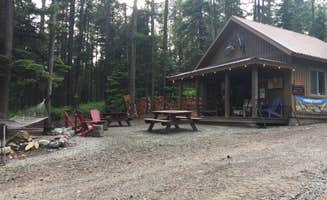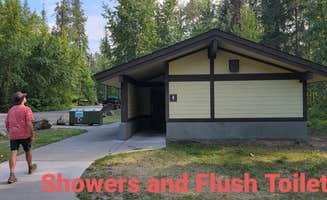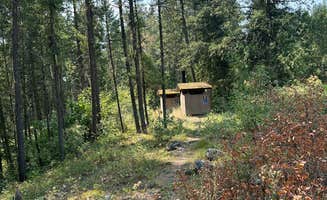Primitive campsites dominate the landscape near Eureka, Montana, offering visitors a rustic experience in the Kootenai National Forest. The region sits at approximately 2,600 feet elevation with dense forest surroundings and access to multiple waterways. Most campgrounds operate seasonally from late May through early September due to heavy winter snowfall.
What to do
Explore waterways: Big Therriault Lake Campground provides excellent access for water activities. "Absolutely gorgeous lake nestled in the surrounding mountains. Campsites are large with good shade. Lake is picturesque," notes Melissa P. The pristine lake offers swimming and fishing opportunities from late June through early September.
Hike forest trails: Big Creek Campground connects to extensive trail networks in the surrounding Flathead National Forest. "Great hiking in surrounding Flathead Forest outside of park," mentions one visitor. The trails vary from easy 1-2 mile loops to challenging day hikes with significant elevation gain.
Wildlife viewing: The area around Grave Creek Campground provides opportunities to observe native wildlife. "Lot's of deer walking around, very safe, locals are very friendly," reports John P. The region supports populations of deer, elk, moose, and various bird species, though visitors should practice bear safety protocols.
What campers like
Privacy between sites: Whitefish Lake State Park Campground offers secluded camping despite its popularity. "The sites are small and the road is narrow but it is beautiful," according to Angela G. Most sites include natural vegetation buffers creating separation between neighboring campers.
River access: Caribou Campground features proximity to water that campers appreciate. "Three campsites, a gorgeous creek, and a clean vault toilet. It is close to the road but not a busy one, and the sound of the water more than covers any traffic noise," says Barbara C. Direct water access provides both recreational opportunities and natural white noise.
Star viewing: Remote locations like Tuchuck Campground offer exceptional night sky viewing with minimal light pollution. Visitors report "a full sky of stars every night" from these more isolated locations. The best viewing typically occurs during new moon phases when skies remain dark throughout the night.
What you should know
Road conditions: Access to some campgrounds requires careful planning. "The road in is a little tough. When you get to the campground, you realize it was worth it," notes Melissa P. about Big Therriault Lake Campground. Several campsites require travel on unpaved forest roads that may become difficult during wet weather.
Train noise: Yaak River Campground and others near rail lines experience periodic train disruptions. "Road/train noise but not overbearing," mentions Steve H. Frequency varies by location with some sites experiencing hourly train traffic, particularly during overnight hours.
Bear safety: The entire region requires proper food storage due to bear activity. "Keep an eye out and camping location clean due to the bears will visit you if not," advises Brian N. Most established campgrounds provide bear-resistant containers, though dispersed campers should bring appropriate storage options.
Tips for camping with families
Swimming spots: Yaak Falls Campground offers safe water play areas for children. "In late July 2020 I arrived about noon and quickly rinsed off in the surprisingly clear bottom of the falls," reports Jenny H. The horizontal rock formations create natural wading pools appropriate for supervised children during summer months.
Accessible fishing: Several locations offer fishing opportunities suitable for younger anglers. "Moose lake nearby is good for 6 to 8 inch cutthroat," notes Todd J. about Big Creek Campground. These smaller bodies of water typically have better catch rates for beginners compared to larger rivers.
Bug preparation: Insect activity increases near water sources throughout summer months. "I would recommend bug spray to anyone who is prone to mosquito bites. Especially when it's dusk and you are by the river!" advises Talia H. Evening activities particularly benefit from proper insect protection from June through August.
Tips from RVers
Size limitations: Kootenai River Campground accommodates larger vehicles better than most area campgrounds. "About 2/3 of the sites are full hookups. Rest water and electric," reports Patrick B. Other campgrounds have more restrictive size limitations with many limiting RVs to under 25 feet.
Solar challenges: Dense forest canopy affects solar charging capabilities at most sites. "Deep woods feel with all the trees and shade. Solar would be a challenge," notes a visitor to Yaak River Campground. Alternative power sources like generators (where permitted) or battery systems may be necessary for extended stays.
Leveling requirements: Prepare for uneven terrain at most campgrounds. "Some sites are nice and level but others have a heavy slope," explains Angela G. about Whitefish Lake State Park Campground. Bringing adequate leveling equipment helps ensure comfortable positioning regardless of site assignment.




